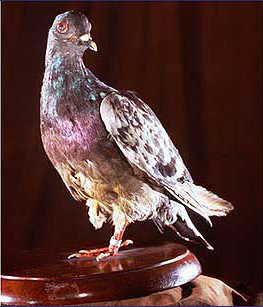Cher Ami: The Pigeon That Saved the Lost Battalion
When people picture a soldier, they rarely imagine feathers, a beak, and wings — but one pigeon proved that heroism can come in the most unlikely forms. During World War I, a homing pigeon named Cher Ami helped save nearly 200 American soldiers during one of the war’s most harrowing battles. His bravery in the skies earned him medals, global recognition, and a lasting place in military history.
A Feathered Messenger of War
Cher Ami — French for “dear friend” — was born in 1918 and became part of the U.S. Army Signal Corps’ Pigeon Service. At the time, communication on the battlefield was unreliable; telephones and radios were new technologies that often failed in harsh conditions. Homing pigeons, on the other hand, had a remarkable ability to return to their home lofts over long distances and unfamiliar terrain. Scientists later discovered that pigeons like Cher Ami navigate using low-frequency sound waves to create “sound maps,” guiding them home even across unknown land.
Cher Ami was one of 600 pigeons sent to France to assist American troops. Messages were written on tiny pieces of paper, tucked into canisters, and tied to the birds’ legs. Despite increasing danger from enemy sharpshooters who had learned to target these flying messengers, Cher Ami completed 12 successful missions — an extraordinary achievement.
The Mission That Made History
Cher Ami’s most famous flight took place during the Meuse-Argonne Offensive in October 1918. The 77th Division, later known as the “Lost Battalion,” was surrounded by German forces in the dense Argonne Forest. With communication lines cut and radios failing, the unit was unable to inform American forces of their position. Worse still, American artillery began mistakenly shelling their own troops, unaware they were targeting friendly forces.
With desperation setting in, Major Charles Whittlesey turned to his last hope — a single surviving pigeon: Cher Ami. The note tied to the bird’s leg read:
“We are along the road parallel to 276.4. Our own artillery is dropping a barrage directly on us. For heaven’s sake, stop it.”
As Cher Ami took flight, German bullets filled the air. He was struck mid-flight, shot through the chest, and fell — but miraculously rose again. In less than 30 minutes, Cher Ami flew 25 miles back to the American base. Gravely wounded, blind in one eye, and with a nearly severed leg, Cher Ami still delivered the life-saving message. Thanks to his bravery, the shelling ceased, and 194 men were saved.
A National Hero
After the war, Cher Ami was treated by medics and nursed back to health by his handler, Capt. John Carney. Although he never fully recovered — he lost a leg and his eyesight — his courageous act made him a national hero. He was awarded the French Croix de Guerre and honored by General John Pershing, who declared, “There isn’t anything the United States can do too much for this bird.”
Cher Ami returned to the United States and lived out the rest of his short life at Fort Monmouth, New Jersey, passing away on June 13, 1919. His body was taxidermied and placed on display at the Smithsonian Institution in 1921, where he remains to this day, inspiring visitors with his extraordinary story.
Settling a Century-Old Mystery
For many years, Cher Ami was referred to as female, based on records from the time. However, in 2021, to mark the 100th anniversary of his display at the Smithsonian, DNA testing was performed — and the results confirmed that Cher Ami was, in fact, male.
Legacy of a Feathered Hero
Cher Ami’s story reminds us that courage comes in all forms — not just in uniform, but also in feathers. He is remembered as one of the most unlikely yet effective heroes of World War I, proving that even a humble pigeon can change the course of history.
Cher Ami’s legacy lives on at the Smithsonian’s National Museum of American History, where his preserved body stands as a testament to the valor of the smallest soldiers.


0 Comments